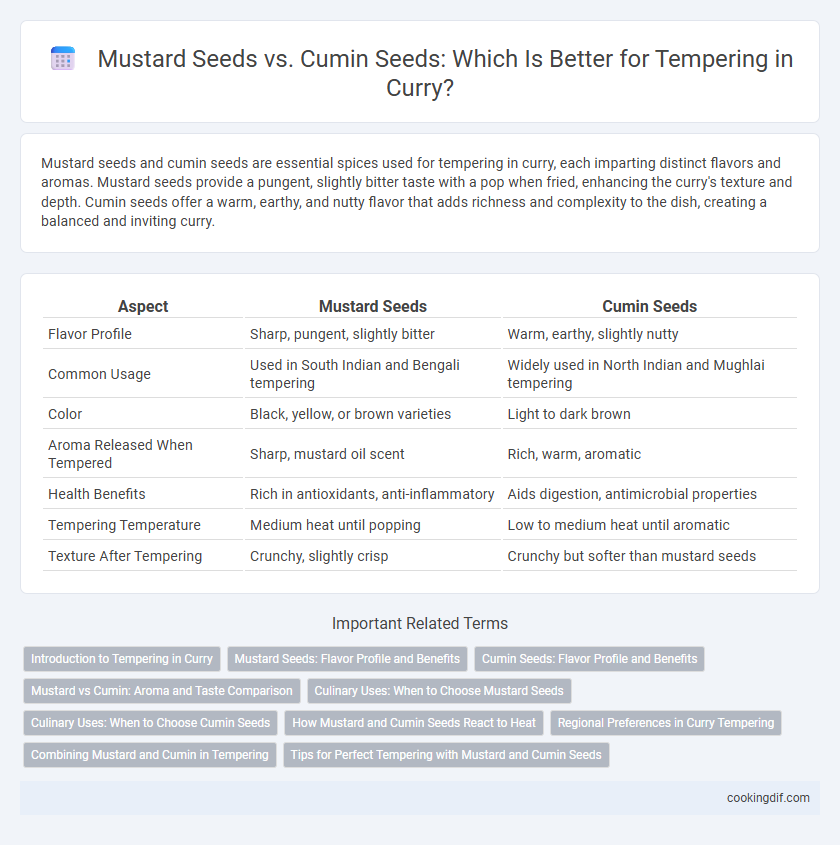Mustard seeds and cumin seeds are essential spices used for tempering in curry, each imparting distinct flavors and aromas. Mustard seeds provide a pungent, slightly bitter taste with a pop when fried, enhancing the curry's texture and depth. Cumin seeds offer a warm, earthy, and nutty flavor that adds richness and complexity to the dish, creating a balanced and inviting curry.
Table of Comparison
| Aspect | Mustard Seeds | Cumin Seeds |
|---|---|---|
| Flavor Profile | Sharp, pungent, slightly bitter | Warm, earthy, slightly nutty |
| Common Usage | Used in South Indian and Bengali tempering | Widely used in North Indian and Mughlai tempering |
| Color | Black, yellow, or brown varieties | Light to dark brown |
| Aroma Released When Tempered | Sharp, mustard oil scent | Rich, warm, aromatic |
| Health Benefits | Rich in antioxidants, anti-inflammatory | Aids digestion, antimicrobial properties |
| Tempering Temperature | Medium heat until popping | Low to medium heat until aromatic |
| Texture After Tempering | Crunchy, slightly crisp | Crunchy but softer than mustard seeds |
Introduction to Tempering in Curry
Tempering in curry involves heating mustard seeds or cumin seeds in oil to release their essential oils and enhance the dish's aroma and flavor. Mustard seeds provide a sharp, pungent taste with a slight bitterness that complements lentil-based curries, while cumin seeds offer a warm, earthy flavor ideal for vegetable and meat curries. Choosing between mustard and cumin seeds depends on the desired flavor profile, with both playing a crucial role in traditional Indian tempering techniques.
Mustard Seeds: Flavor Profile and Benefits
Mustard seeds offer a sharp, pungent flavor that intensifies when tempered, releasing a nutty aroma essential for authentic curry preparation. Rich in antioxidants, mustard seeds contribute to digestive health and possess anti-inflammatory properties that enhance the overall nutritional value of the dish. Their rapid popping in hot oil creates a distinctive texture and deepens the complexity of curry flavors compared to the earthier, warmer notes of cumin seeds.
Cumin Seeds: Flavor Profile and Benefits
Cumin seeds offer a warm, earthy flavor with a hint of bitterness that enhances curry dishes by adding depth and complexity. Rich in antioxidants and known for digestive benefits, cumin seeds aid in reducing bloating and improving nutrient absorption. Their robust aroma and health properties make them a staple in tempering, elevating both taste and wellness in curries.
Mustard vs Cumin: Aroma and Taste Comparison
Mustard seeds release a sharp, pungent aroma and a slightly bitter, tangy taste when tempered, enhancing dishes with a bold, vibrant flavor profile. Cumin seeds give off a warm, earthy aroma characterized by a nutty, slightly sweet taste that adds depth and richness to curry dishes. Compared to cumin, mustard seeds offer a more intense and spicy sensory experience, while cumin provides a mellower, smoother undertone essential for balanced seasoning.
Culinary Uses: When to Choose Mustard Seeds
Mustard seeds release a sharp, pungent flavor ideal for tempering dishes like dals, pickles, and vegetable stir-fries in Indian cuisine, especially when a bold, slightly bitter undertone is desired. They pop and crackle quickly in hot oil, infusing the dish with a nutty aroma that complements mustard greens, lentils, and coconut-based curries. Choose mustard seeds over cumin seeds when preparing recipes that benefit from their distinct spice profile and vibrant seasoning effect.
Culinary Uses: When to Choose Cumin Seeds
Cumin seeds are preferred for tempering in dishes that require a warm, earthy flavor with slightly bitter undertones, commonly found in North Indian and Middle Eastern cuisines. Their robust aroma and complex taste enhance lentils, vegetables, and meat curries, creating a deeper flavor profile than mustard seeds, which impart a sharper, mustardy heat. Cumin seeds are ideal for slow-cooked recipes where their flavor infuses gradually, complementing spices like coriander and turmeric in traditional curry preparations.
How Mustard and Cumin Seeds React to Heat
Mustard seeds pop and release a nutty, pungent aroma quickly when heated in oil, adding a sharp, slightly bitter flavor to curries. Cumin seeds, by contrast, sizzle gently and emit a warm, earthy fragrance, contributing a deep, aromatic base without burning easily. Both seeds react differently to heat, with mustard requiring careful attention to avoid bitterness, while cumin offers a milder, slower flavor release during tempering.
Regional Preferences in Curry Tempering
Mustard seeds are predominantly used in South Indian curry tempering, providing a sharp, pungent flavor that enhances dishes like sambar and rasam. Cumin seeds are favored in North Indian and Gujarati curries, offering a warm, earthy aroma that complements lentils and vegetable stews. Regional cooking styles influence the choice between these seeds, reflecting varied flavor profiles and traditional culinary practices.
Combining Mustard and Cumin in Tempering
Combining mustard seeds and cumin seeds in tempering enhances the flavor profile of curries by blending mustard's sharp, pungent notes with cumin's warm, earthy aroma. This duo releases complementary essential oils when fried in hot oil, creating a rich, layered base that elevates the overall taste and aroma of Indian dishes. The balanced use of both seeds adds depth and complexity, making the curry more aromatic and flavorful.
Tips for Perfect Tempering with Mustard and Cumin Seeds
Use mustard seeds for tempering to add a sharp, pungent flavor that enhances South Indian curries, but be sure to heat the oil until the seeds begin to pop to avoid bitterness. Cumin seeds provide a warm, earthy aroma ideal for North Indian dishes; gently toast them in hot oil until they release their fragrant oils without burning. For perfect tempering, control the oil temperature precisely, add seeds at the right moment, and stir constantly to balance their distinct flavors and aromas in your curry.
Mustard seeds vs Cumin seeds for tempering Infographic

 cookingdif.com
cookingdif.com